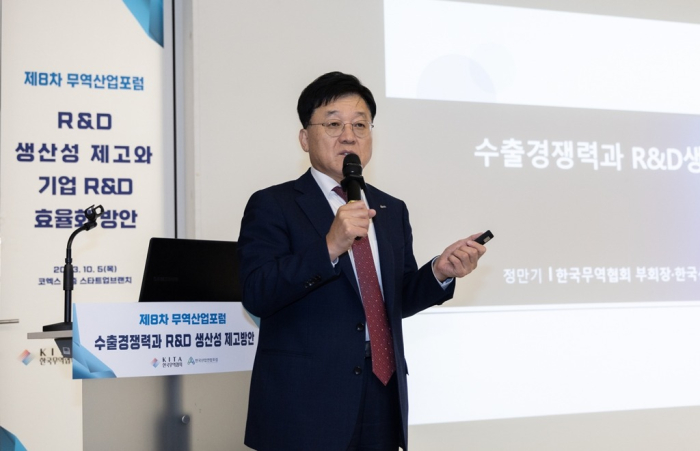Research & Development
S.Korea’s corporate R&D spending lags global rivals
A private business group calls for increases in R&D tax credits for large companies as Korea decides to cut its 2024 R&D budget
By Oct 05, 2023 (Gmt+09:00)
3
Min read
Most Read
LG Chem to sell water filter business to Glenwood PE for $692 million


Kyobo Life poised to buy Japan’s SBI Group-owned savings bank


KT&G eyes overseas M&A after rejecting activist fund's offer


StockX in merger talks with Naver’s online reseller Kream


Mirae Asset to be named Korea Post’s core real estate fund operator



Major South Korean companies’ spending on research and development lags investments made by their global competitors due to lower government tax incentives in the country, causing it to lose competitiveness in the world’s market, a private business lobby group said on Thursday.
The country’s total corporate R&D spending accounted for 3.5% of sales on average as of 2021, falling short of 7.8% of the US, 3.9% of Japan and 3.6% of China, showed a study by the Korea International Trade Association (KITA) based on the EU Industrial R&D Investment Scoreboard data.
The number of South Korean companies on the list of top 2,500 companies of R&D spending shrank to 53 in 2021 from 80 in 2013, the KITA said, citing the scoreboard. The number of Chinese companies on the list more than tripled to 678 from 199 during the period.
In the semiconductor sector, Samsung Electronics Co. and SK Hynix Inc., the world’s two largest memory chipmakers, spent 8.1% and 9.6% of their sales on R&D, respectively, in 2021, the KITA said. Qualcomm Inc., the world’s leading mobile chip maker, and Nvidia Corp., a global chip designer, invested 21.4% and 19.6%, respectively, while MediaTek Inc., a Taiwanese fabless semiconductor company, spent 19.2%.
Hyundai Motor Co. and Kia Corp., the world’s No. 3 automaker together, invested only 2.6% and 0.9%, respectively, the lowest among the top 13 companies of R&D expenditures in the sector.
“That is a result of the sustained decline in tax credits for R&D spending for large companies,” said Kim Kyoung-hoon, the leader of the KITA’s supply chain research team, adding the government provides much larger tax benefits to small and medium-sized enterprises (SMEs) for their R&D.
SMALLER TAX CREDITS FOR LARGE FIRMS’ R&D
South Korea’s implied tax subsidy rate on R&D expenditures for large firms stood at a mere 0.02 in 2022, according to the Organisation for Economic Co-operation and Development (OECD), far lower than an average of 0.16 of the intergovernmental body with 38 member countries, the KITA said.
On the other hand, the Asian nation’s tax subsidy rate for SMEs was 0.26, higher than the OECD average of 0.2.
South Korea’s Ministry of Trade, Industry and Energy increased the allocation of its R&D budget for SMEs to 42.7% in 2021 from 25.5% in 2011 while cutting the allotment for large companies to 5% from 17.7% during the period, according to the KITA. The Ministry of SMEs and Startups also raised its R&D spending to more than 1 trillion won ($740 million) in 2019 from 650 billion won in 2011.
The government also reduced R&D tax credits for large companies to 0-2% after 2018, although it maintained the incentives for SMEs at 25%, the body said.
That forced large companies to decrease R&D, resulting in losing their shares in the global markets, KITA Executive Vice Chairman Jeong Marn-Ki.
“Our market share in the world’s export market fell to 2.59% in the first half, a level in 1999, from 3.23% in 2017 and 2.85% in 2019,” Jeong said.
It is essential to secure value competitiveness based on technology as local companies struggle to improve price competitiveness due to rising labor costs, Jeong said.
To meet the goal, the country needs to increase support for large companies’ R&D, Kim said.
“The government must raise the tax subsidy rate on R&D and talent development expenditures for large companies to reduce the tax support gap between major firms and SMEs,” Kim said.
“The authorities also need to expand support for large firms in general industries, which receive less tax incentive than those of other countries, in addition to national strategic technologies, as well as new growth and original technologies.”
The call for more tax subsidies came after the government announced a plan to cut its R&D budget for next year by 16.6% to 25.9 trillion won.
Write to Mi-Sun Kang at misunny@hankyung.com
Jongwoo Cheon edited this article.
More to Read
-
 EconomyKorean Sept export drop eases as chip sales hit 1-year high
EconomyKorean Sept export drop eases as chip sales hit 1-year highOct 02, 2023 (Gmt+09:00)
2 Min read
Comment 0
LOG IN


